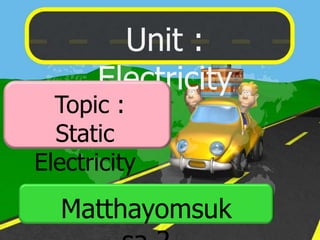
CLIL
- 1. Unit : Electricity Topic : Static Electricity Matthayomsuk
- 2. Physic
- 3. objecti vetell which materials To are conductor and also which materials are insulators To exemplify the materials that cause static electricity
- 5. vocabulary
- 6. electron
- 7. insulator
- 8. conductor
- 9. material
- 10. ELECTRICAL CHARGES Protons, neutrons and electrons are very different from each other. They have their own properties, or characteristics. One of these properties is called an electrical
- 11. Protons have what we call a "positive" (+) charge. Electrons have a "negative" (-) charge. Neutrons have no charge, they are neutral. The charge of one proton is equal in strength to the charge of one electron. When the number of protons in an atom equals the number of
- 12. ELECTRONS CAN MOVE The protons and neutrons in the nucleus are held together very tightly. Normally the nucleus does not change. But some of the outer electrons are
- 13. They can move from one atom to another. An atom that loses electrons has more positive charges (protons) than negative charges (electrons). It is positively charged. An atom that gains electrons has more negative than positive
- 15. Some materials hold their electrons very tightly. Electrons do not move through them very well. These things are called insulators. Plastic, cloth, glass and dry air are good insulators. Other materials have some loosely held
- 16. How can we move electrons from one place to another? One very common way is to rub two objects together. If they are made of different materials, and are both insulators, electrons may be transferred (or moved) from
- 17. The more rubbing, the more electrons move, and the larger the static charge that builds up. (Scientists believe that it is not the rubbing or friction that causes electrons to move. It is
- 18. Experime nt on Static Electricit y
- 19. Activit y1 There will be an experiment. You have to follow the steps below: - Make a group of 4 people. - The experimental equipments are given for you.
- 20. Equipme nts
- 22. a plastic cup
- 23. a candl e
- 24. plasti c tube
- 25. a handker chief
- 26. a spoon
- 27. a straw
- 28. a bowl
- 29. a stick
- 30. time to do the experiment !
- 31. Step 1 One of each group picks a plastic cup up.
- 32. Step 2 Put a bowl on the table. Step Hold a plastic 3 cup directly above the bowl.
- 33. Step Pour the water 4 in the bottle into a plastic Ste You .can see cup p5 the water is dropping from the plastic cup.
- 34. Another one of Step 6 each group picks a Ste Use a handkerchief p7 handkerchief and stick up. rub a stick as fast long as you can.
- 35. would like you Step 8 to close the stick to Step dropping the Everyone in 9 each group water observes or notices what’s happening
